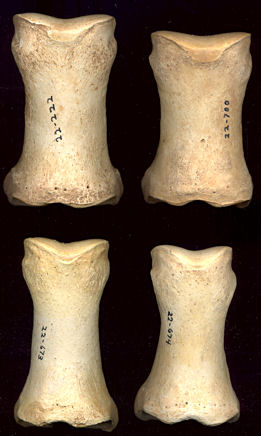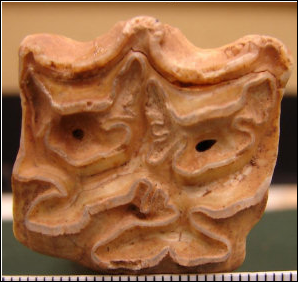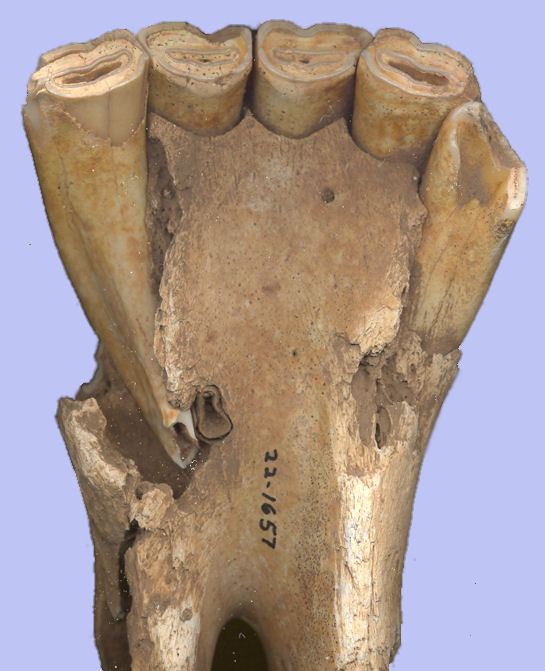Class Mammalia
Order Perissodactyla
Family Equidae
Equidae—Family Equidae // Equidae sp.—Horses // Equus sp. (small)—Small Horse // Equus sp (large)—Large Horse // Equus calobatus—Stilt-legged Onager // Equus conversidens—Mexican Horse // Equus cumminsii—Cummings' Ass // Equus enormis—Enormous Horse // Equus fraternus—Fraternal Horse // Equus giganteus—Giant Horse // Equus occidentalis—Western Horse // Equus pacificus—Pacific Horse // Equus (Plesippus) sp.—American Zebra // Equus (Plesippus) francescana—Francescana Zebra // Equus (Plesippus) simplicidens—American Zebra // Equus Species A—Unidentified Equus // Haringtonhippus francisci—Harington's Stilt-legged Horse

Synonyms. Equus bautistensis, Equus caballus caballus, E. caballus laurentius, E. excelsus, E. laurentius, E. midlandensis, E. niobrarensis.

Fig. 1. Comparison of the first phalanges of E. scotti (top) and E. conversidens (bottom). Anterior phalanges are on the left and posterior phalanges on the right.
This is a medium-size horse that commonly occurs together with E. conversidens in Southwestern fossil faunas. Harris and Porter (1980) give a number of measurements separating E. scotti (as E. niobrarensis) from E. conversidens, and later considered E. niobracensis as a synonym of E. scotti. More recently, Barrón-Ortiz et al.(2017) recognized a single caballine horse in the interior western North America to which they applied the name Equus ferus scotti—thus placing this taxon as a subspecies of the wild caballine horses of the Old World. Although Equus ferus is becoming more commonly used for the wild stock from which the domestic horse was derived, I will use E. scotti until the positions of other New World caballine horses are clarified.

Scott (1998:76A) synonymized Equus bautistensis with E. scotti, basing this on:
1) large size; 2) short, stout metapodials; 3) bilobate protocones in P3-4 with a strong anterior heel; 4) ectoflexids in M1-2 which approach but do not fully penetrate the molar isthmus; and 5) closed infundibulae in I1-2 and an open infundibulum in I3.
Fig. 2 (far right). Right p3-m3 of E. scotti (UTEP 22-1528) showing the cheek tooth characteristics of E. scotti.


Fig. 3 (left). Anterior lower jaw of E. scotti showing L i1-2 and R i1-3.
Fig. 4 (near right). Right P4 of E. scotti showing nature of the protocone (bottom of figure).
Many of the records listed below were published as E. niobrarensis.
Sites
Pleistocene: Agua Negra (Morgan and Lucas 2005); Denton Ranch (Morgan and Lucas 2006); Gobernador (Morgan and Lucas 2005); Jemez Springs (Morgan and Lucas 2005); Lemitar (Morgan et al. 2009: cf.); Nash Draw (Harris 1993c, UTEP); Perico Creek (Morgan and Lucas 2005); Plaza Larga Creek (Morgan and Lucas 2003); Sandia Gravel Pit (Morgan and Lucas 2003); Steins (Morgan and Lucas 2005, UTEP: ?); Tome (Morgan and Lucas 2005); West Fork Kutz Canyon (Morgan and Lucas 2005).
Latest Blancan: Caballo (Morgan et al. 2011); La Union (Morgan and Lucas 2003); Santo Domingo (Morgan and Lucas 2003); Virden (Morgan and Lucas 2003).
Late Blancan/Early Irvingtonian: Elsinore: Mimomys (Pajak et al. 1996).
Irvingtonian: Bautista Badlands (Frick 1921); El Golfo (Croxen et al. 2007: aff.); Elsinore: Microtus/Mammuthus (Pajak et al. 1996).
Early Irvingtonian: Adobe Ranch (Morgan and Lucas 2003); El Casco, San Timoteo Badlands (Albright 2000); Hells Canyon (Morgan and Lucas 2005); Tijeras Arroyo (Morgan and Lucas 2005).
Medial Irvingtonian: Gutierrez Gravel Pit (Morgan and Lucas 2005).
Late Irvingtonian: Elsinore: Pauba Formation (Pajak et al. 1996).
Late Irvingtonian or Early Rancholabrean (?): Taiban Creek (Morgan and Lucas 2005).
Early Rancholabrean: Albuquerque Gravel Pits (Morgan and Lucas 2005).
Rancholabrean: Alkali Spring (Morgan and Lucas 2005); Casados Ranch (Morgan and Lucas 2005); Jal (Morgan and Lucas 2005); Park La Brea A (Jefferson 2014); Tramperos Creek (Morgan and Lucas 2005); Twenty Five Mile Stream (Morgan and Lucas 2005).
Mid Wisconsin: Lost Valley (UTEP); Pendejo Cave (Harris 2003; UTEP); U-Bar Cave (Harris 1987; UTEP).
Mid/Late Wisconsin: Dark Canyon Cave (Harris and Porter 1980; UTEP: cf.); Pit N&W Animal Fair (Harris 1993c; UTEP: ?).
Late Wisconsin: Algerita Blossom Cave (UTEP); Anderson Basin et al. (Morgan and Lucas 2005);Animal Fair (Harris and Porter 1980; UTEP); Balcony Room (Harris 1993c; UTEP); Big Manhole Cave (Harris 1993c; UTEP); Beyond Bison Chamber (Harris 1993c; UTEP: cf.); Bison Chamber (Harris and Porter 1980; UTEP: ?); Blackwater Draw Fauna (Slaughter 1975); Burnet Cave (Schultz and Howard 1935, Harris data); Camel Room (Harris and Porter 1980; UTEP); Charlies Parlor (Harris and Porter 1980; UTEP); Circus Route (UTEP); Conkling Cavern (Harris data); Cueva Quebrada (Lundelius 1984: cf.); Harris Pocket (Harris 1989; UTEP); Human Corridor (Harris and Porter 1980; UTEP: cf.); Isleta Cave No. 1 (Harris 1993c; UTEP); Isleta Cave No. 2 (Harris 1993c; UTEP); Lake Estancia (Morgan and Lucas 2005); Placitas (Hibben 1941; UTEP: ?); Salt Creek (UTEP: cf.); Sandia Cave, Sandia Level (Hibben 1941); Sandia Gravel Pit (Morgan and Lucas 2005); Shelter Cave (Harris data: cf.); Sierra Diablo Cave (UTEP: cf.); Stalag 17 (Harris and Porter 1980; UTEP); TT II (Harris and Porter 1980; UTEP); U-Bar Cave 14-15 ka (Harris 1989; UTEP: cf.).
Literature. Barrón-Ortiz et al.; Croxen et al. 2007; Frick 1921; Harris 1987, 1989, 1993c, 2003; Harris and Porter 1980; Hibben 1941; Jefferson 1991b; Lundelius 1984; Morgan and Lucas 2003, 2005, 2006; Schultz and Howard 1935; Scott 1998; Scott et al. 2003; Scott et al. 2010; Slaughter 1975; Winans 1985, 1989.
Last Update: 6 Jul 2018